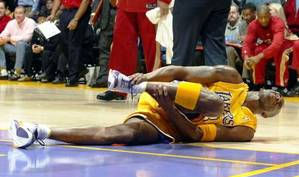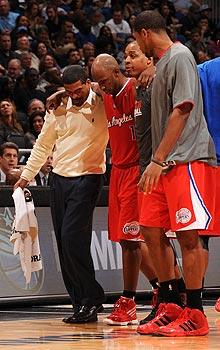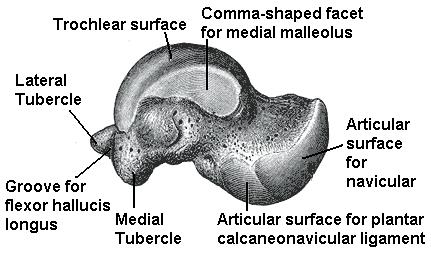by Art Horne

After a severe ankle sprain so much attention is often spent addressing the injured ankle that little time or thought is ever given to how the subsequent pain or the altered gait/weight bearing status of the individual plays into the long term health of the ankle or the entire kinetic chain that sits above it. Because injury within one area of the body may influence muscle activity, muscle recruitment and ultimately pain in another “unrelated” area, it is important for the clinician to both investigate and consider addressing these potential changes as part of their routine examination and rehabilitation programming. With previous injury being the most powerful predictor of future injury, along with previous ankle sprain recurring as a future ankle sprain approximately 80% of the time (Smith, 1986), it’s worth considering another look at how we care for this common ailment. Traditionally, athletic trainers and other health care providers focus on providing PRICE (Protection, Rest, Ice, Compression and Elevation) after an acutely injured ankle but unfortunately continue to address the pathology this way for an extended period of time. Although some forward thinking health care professionals actually do provide high level functional exercises within their rehabilitation program rather than the popular 4-way ankle thera-band exercises and Buso ball balancing acts that usually follow the ever present “ice and e-stim” protocol, very few address the altered function within the hip and hip musculature immediately after injury in an effort to sustain the highest level of athletic ability upon return to play.
Below are two articles that will certainly get you thinking about your own rehabilitation protocol following ankle sprains and perhaps even convince you that squatting and preparing your athletes and patients to squat after injury is not just something that strength coaches should be doing.
The Influence of Ankle Sprain Injury of Muscle Activation during Hip Extension
Bullock-Saxton, J. E., Janda, V., & Bullock, M. I. (1994) The Influence of Ankle Sprain Injury on Muscle Activation during Hip Extension. Int. J. Sports Med. Vol. 15 No. 6, 330-334.
Methods: In this study, authors looked at the function of the hip and specifically hip extension after severe ankle sprain (20 men, aged between 18-35, who had suffered unilateral severe ankle sprain no less than four months earlier who were pain free at the time of the study) and compared them to eleven matched controls. Muscle activation during prone hip extension was measured using electromyography on the motor points of ipsilateral and contralateral lumbar spinae extensors along with the hamstrings and gluteus maximus muscles of both lower limbs.
Results: “In summary, comparisons revealed that for the control group, the pattern of activation was consistent between sides of the body, and the timing of muscle activation of each of the four monitored muscles was almost simultaneous. In contrast, for the experimental group, on the whole the patterns showed little consistency within the subject nor between sides, while there was a greater spread in timing of muscle activation in both injured and uninjured limbs, particularly contributed to by the more marked delay in activation of the gluteus maximus muscle.” (pg. 333)
Discussion:
“the results highlight the importance of the clinician’s paying attention to function of muscles around the joints separated from the site of injury. Significant delay of entry of the gluteus maximus muscle into the hip extension pattern is of special concern, as it has been proposed by Janda that the early activation of this muscle provides appropriate stability to the pelvis in such functional activities as gait. Without this support, compensatory muscle activity and movement is likely to occur in the low back, possibly contributing to the development of low back pain.” (pg. 333)
“the marked differences in muscle activation in both the injured and uninjured sides and their implications for development of further symptomatology, do emphasis the need for a broad ranging client assessment with treatment directed at improving appropriate muscle activation and co-ordination to ensure the comprehensive management of the injury.” (pg. 333)
_____________________________________________________________________________________
Clinical Pearls:
1. Pain is unpredictable and far reaching. By utilizing the SFMA as part of your evaluation process clinicians may address contributing problems and/or motor control deficits that otherwise would have gone unnoticed. You’ll be amazed on how many patients that present to you with complaints OTHER than ankle pain often forget to mention that they have had a severe ankle sprain in the past just as you witness them topple over during the Single Leg Stance (Stork Test).
2. Evaluation of any injury must also incorporate the evaluation of whole body movement patterns as a means to both addressing performance limitors as well as possible contributions to future injury.
_____________________________________________________________________________________
Ipsilateral Hip Abductor Weakness after Inversion Ankle Sprain
Friel, K., McLean, N., Myers, C., & Caceres, M. (2006). Ipsilateral Hip Abductor Weakness After Inversion Ankle Sprain. Journal of Athletic Training. Vol. 41 No.1, 74-78
Methods: 23 subjects with unilateral chronic ankle sprain were recruited. Subjects had at least 2 ipsilateral ankle sprains and were bearing full weight, with the most recent injury occurring at least 3 months earlier. They were not undergoing formal or informal rehabilitation at the time of the study. Researchers obtained goniometric measurements for all planes of motion at the ankle while handheld dynamometry was used to assess the strength of the hip abductor and hip extensor muscles in both limbs.
Results: Hip abductor muscle strength and plantar flexion were significantly less on the involved side than the uninvolved side (P< 0.001 in each case). Strength of the involved hip abductor and hip extensor muscles was significantly correlated (r=0.539, P < 0.01). No significant difference was noted in hip extensor muscle strength between sides ( P = 0.19).
Discussion: Our subjects with unilateral chronic ankle sprains had weaker hip abduction strength and less plantar flexion range of motion on the involved sides. Clinicians should consider exercises to increase hip abduction strength when developing rehabilitation programs for patients with ankle sprains.
_____________________________________________________________________________________
Additional Commentary:
“Our findings of weaker hip abductors in the involved limb of people with chronic ankle sprains supports this view of a potential chronic loss of stability throughout the kinetic chain or compensations by the involved limb, thus contributing to repeat injury at the ankle.” (pg. 76)
“If the firing, recruitment, and strength of the hip abductor muscles in people with ankle sprains have been altered because of the distal injury, the frontal-plane stability normally supplied by this muscle is lacking, and the risk for repeat injury increases. Weak hip abductors are unable to counteract the lateral sway, and an injury to the ankle may ensue.”
1. I remember Charlie Weingroff telling me that he had never met a flat arch that the hip couldn’t fix. Of course this is not entirely true, and Charlie would admit this as well, but the fact remains that the hip has a tremendous effect on lower extremity function including your arch and of course your ankle.
2. Treatment protocols that include evaluation and strengthening of the hip must be established after injury to the ankle. Rehabilitation of proximal structures should be prominent within any lower extremity injury rehabilitation programming.
_____________________________________________________________________________________
Conclusions and Final Thoughts:
No longer should injury be treated as an isolated insult to a specific joint, ligament or muscle. Both injury itself and the pain produced as a result from the injury have far reaching ramifications that require clinicians to incorporate evaluation and rehabilitation techniques that involve joints above and below the site of insult. Clinicians must develop a keen sense and an appreciation for whole body movement patterns and address aberrant patterns when they present themselves. Both the double leg and single leg squat patterns are time efficient tests that provide the attentive clinician an opportunity to observe such troubling patterns.
Functional return to play guidelines and testing need to incorporate measures not just related to ankle strength and range of motion but must also include measures related to the hip. Hand held dynamometer measures taken during annual pre-participation screenings can both be used as a baseline to compare after injury or used to tease out those individuals on entry with less than optimal hip strength from a previous unresolved injury. Those individuals that have significant side-to-side differences can immediately be given additional exercises and attention in an effort to both improve performance and possibly reduce the likelihood of future injury. Other pre-participation screening tests include single leg wall sit or single leg hop for distance which will provide additional information in the form of strength, power and motor control.
References:
Bullock-Saxton, J. E., Janda, V., & Bullock, M. I. (1994) The Influence of Ankle Sprain Injury on Muscle
Activation during Hip Extension. Int. J. Sports Med. Vol. 15 No. 6, 330-334.
Friel, K., McLean, N., Myers, C., & Caceres, M. (2006). Ipsilateral Hip Abductor Weakness After Inversion
Ankle Sprain. Journal of Athletic Training. Vol. 41 No.1, 74-78
Smith RW, Reischl SF. Treatment of ankle sprains in young athletes. Am J Sports Med. 1986;14:465-471.






